Αll around us, pleasure craft leisurely criss-cross the caldera and carefree tourists take photos of the enchanting volcanic landscape. Meanwhile, from the dimly lit monitor room of the German research vessel R/V Poseidon, we watch an underwater mission that is not for the faint of heart.
The pilot of PHOCA, a remotely operated vehicle (ROV), is attempting to collect samples from solid lava rock at a depth of 260m on the southern walls of the caldera. The rock is exceptionally hard and, to make matters more difficult, the ROV changes position each time its steel manipulator arms exert any pressure on the petrified lava. But the pilot persists. Again and again. Finally, a piece of lava is pried loose and maneuvered into a special box. The scientists are eager to collect more samples before the sun goes down.
When the ROV surfaces, the technicians immediately carry out maintenance work to ready it for the next mission, the scientists take the samples to the laboratory and a second team – the night shift, whose task is to map the seabed – get to work. In the meantime, we visitors have gotten a small taste of the setbacks, the suspense and the feeling of satisfaction gained from a research project aimed at shedding light on the origin of volcanic activity around Santorini a million years ago.
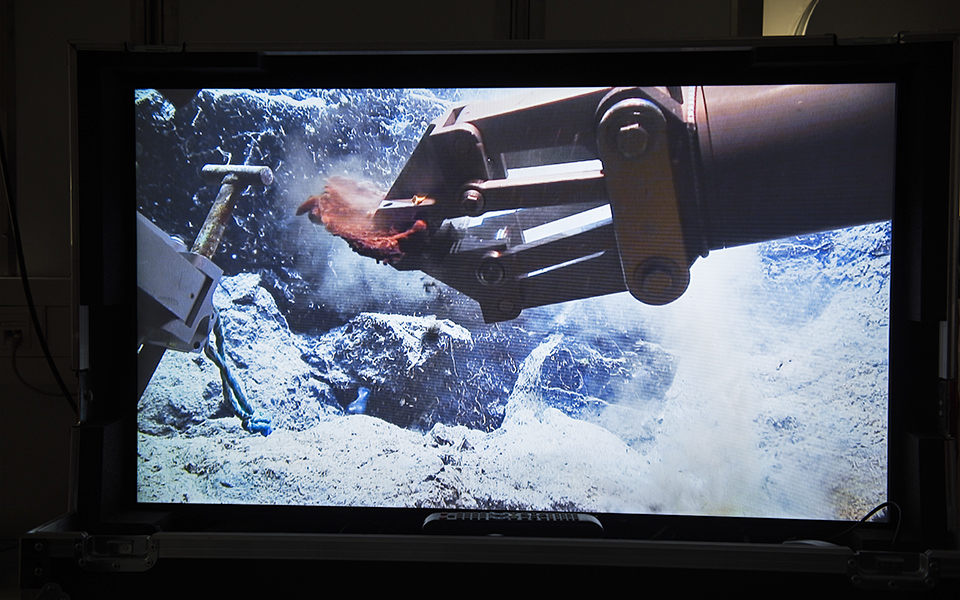
© Vangelis Zavos
The distant past may hold the answers to questions about how the volcano is likely to behave in the future. “The sea hides all the secrets. We have examined the land thoroughly. All the eruptions of Santorini took place underwater,” says Paraskevi Nomikou, Assistant Professor of Geological Oceanography and Natural Geography at the National and Kapodistrian University of Athens and one of the world’s leading experts on the Santorini volcano.
During the past 500,000 years, the volcano has erupted and been reborn from its ashes 12 times, bringing dramatic changes to the physical structure of the islands around it. The devastating eruption that occurred around 1610 BC broke up the formerly single island of Strongyli into three separate isles – Thera, Therasia and Aspronisi – and created the caldera, an enormous rectangular lagoon measuring approximately 12x7k with a depth of up to 392m, surrounded on three sides by steep cliffs 300m high.
Underwater geophysical surveys have revealed that, during the Minoan eruption, the strongest of the past 10,000 years, approximately 40 cubic kilometers of pyroclastic flows were deposited on the seabed around Santorini. The gigantic tsunami triggered by the eruption devastated the northern coast of Crete, leading eventually to the collapse of Minoan civilization.”We have a new theory that the tsunami was not in fact caused by the collapse of the caldera, but by these pyroclastic flows that hurtled down the slopes of the volcano and hit the sea with violent impact,” says Dr. Nomikou. “The sea floor is revealing the truth.”
In the centuries that followed, there have been other, less powerful, eruptions, such as those between 1707 and 1711 which created the islet of Nea Kameni – where visitors can walk on the still active volcano – and the most recent, in 1950, which created the youngest volcanic rocks in the eastern Mediterranean. Signs of activation accompanied by intense seismic activity in 2011-2012 rekindled scientific interest in the volcanic system of Santorini and more particularly in the submarine volcano Kolumbo, located 7k to the northeast.
Kolumbo erupted in 1650 and is currently the most active and potentially dangerous volcano in the Aegean Sea. Recently, scientists from Italy and Greece discovered that its crater, whose floor lies at a depth of 500m below sea level, is emitting powerful bursts of fluids and gases approximately every two minutes: a phenomenon known as volcanic “breathing.”
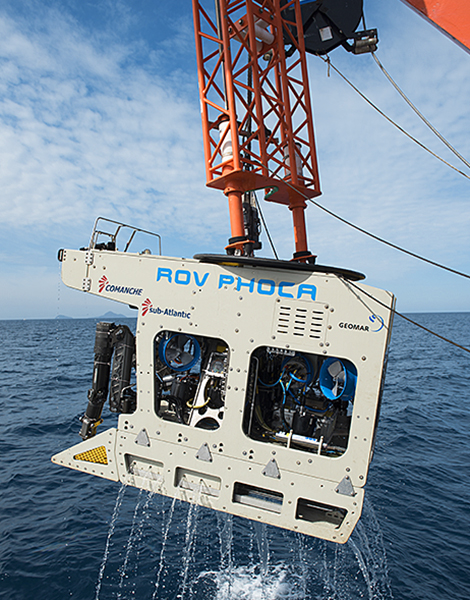
© Vangelis Zavos
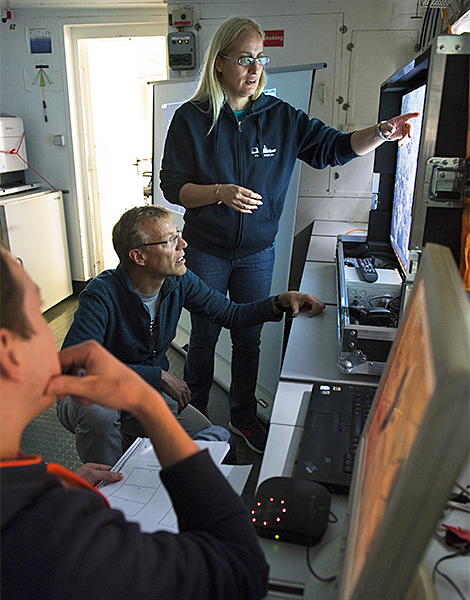
© Vangelis Zavos
The first systematic bathymetric mapping of the seabed in the wider region of the Santorini volcanic complex, extending over 2,300 square kilometers, was carried out in 2001. This was the first time that the caldera and the structure of Kolumbo were mapped in great detail. In addition, at least 20 more submarine volcanic cones were discovered north-east of Santorini, between the islands of Anydros and Ios.
Subsequent expeditions brought to light the active hydrothermal field of the volcano at a depth of 500m, with chimneys emitting fluids and gases at temperatures up to 220oC. Samples were collected from the chimneys, along with the gases and fluids which indicate activity levels as well as the bacteria covering the seabed.
A turning point in efforts to locate the magma chamber of Santorini came with the international experiment known as PROTEUS (Plumbing Reservoirs Of The Earth Under Santorini), which was carried out in late 2015 by Greek, US and British scientists aboard the most advanced seismic vessel in the world, the R/V Marcus G. Langseth.
This was the first time that an exhaustive study was conducted of the Amorgos-Santorini underwater region and geophysical maps were made of the geometry of the magma chamber system of the Santorini-Kolumbo volcanic complex, with ten times more detail than for any other volcano in the world.
To achieve this, 91 specially designed seismometers were installed on the seafloor, along with a further 65 on land. “The study of active structures in the underwater region of Amorgos is of paramount importance to us, since it allows us to pinpoint the seismic fault that caused the devastating earthquake on Santorini in 1956. We are studying the region to learn as much as possible about the quake, because the more we know, the better prepared we will be,” notes Dr. Nomikou.
Last spring, the baton was taken up by the German research vessel R/V Poseidon of the Kiel-based GEOMAR – Helmholtz Centre for Ocean Research, one of the world’s leading marine science institutes. The aim of the mission, headed by Dr. Jörg Geldmacher, was not just to shed ample light on present activity, but to look at the past as well: to ascertain, by means of underwater sampling, the history of this volcano’s evolution.
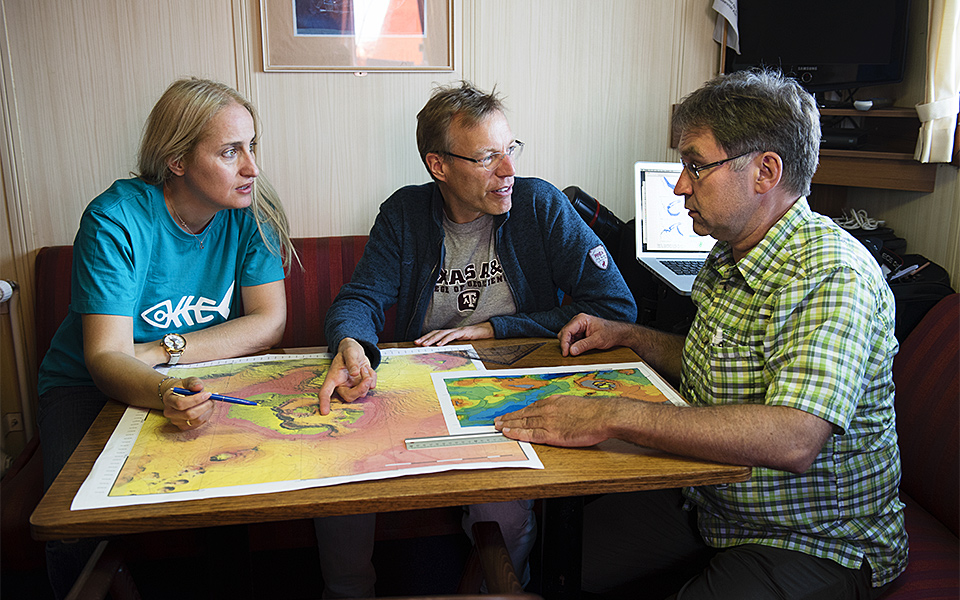
© Vangelis Zavos
The R/V Poseidon is not the newest (built in 1976) nor the largest (length 60.8m) research vessel of the German Research Fleet but it has proven itself worthy in seas around the world, from Greenland to Cape Verde, hosting various teams of scientists. In early March, it launched the autonomous underwater vehicle “Abyss” between Santorini and Amorgos, mapping 100 square kilometers of the seabed and searching for traces of tectonic activity and submarine eruptions.
This was the first time that an active volcano in the Aegean has been mapped with such high definition using this method. “During a second expedition in April, we conducted 6 ROV surveys (photogrammetric mapping), 15 ROV sampling dives, 21 dredge hauls, 43 wax corer deployments and 5 CTD stations (with water sampling). During the nights, we completed 906 nautical miles of multibeam mapping,” says Dr. Geldmacher. After two months, and alternating emotions of frustration and success, hundreds of rock and mineral samples have been collected for analysis.
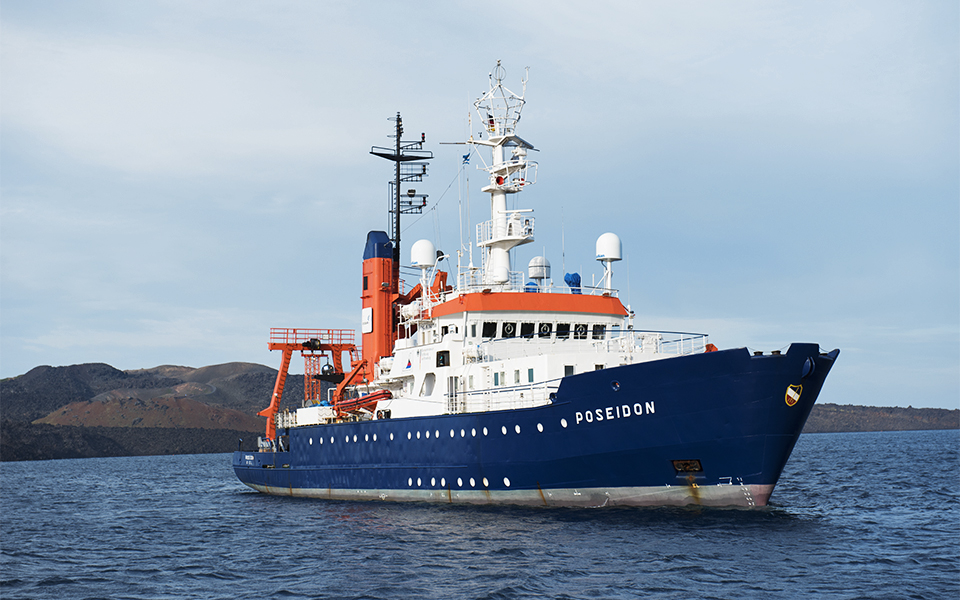
© Vangelis Zavos
Nature has not yet revealed all her secrets. Nothing can stop the volcano, but every effort is being made to control its impact on human life.
Volcanologists and other experts from around the world are systematically studying, recording and observing seismic activity in the area, the level of the coastline, changes in temperature and the composition of the vapors and hot springs, all as part of a reliable monitoring system that allows them to predict when the next volcanic eruption will occur within a window of a few months to a year.
Thanks to an increasing body of knowledge, the rest of us can simply enjoy the results of the geological events that formed the caldera and gave Santorini’s colorful rocks their special beauty.












